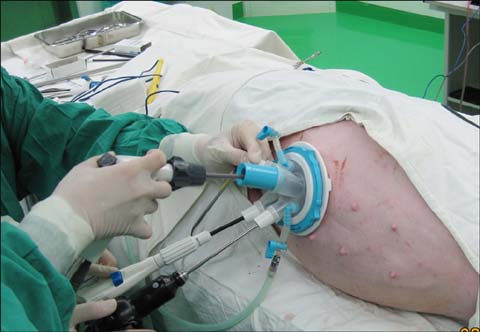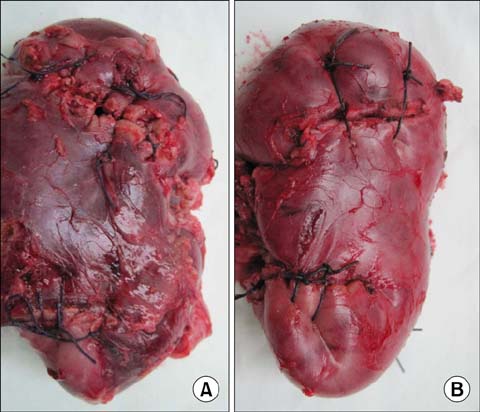Korean J Urol.
2011 Jan;52(1):44-48.
Feasibility of Laparoendoscopic Single-Site Partial Nephrectomy in a Porcine Model
- Affiliations
-
- 1Department of Urology, Seoul National University College of Medicine, Seoul, Korea.
- 2Department of Urology, Seoul National University Bundang Hospital, Seongnam, Korea.
- 3Department of Urology, Seoul Metropolitan Government-Seoul National University Boramae Medical Center, Seoul, Korea. sblee@brm.co.kr
Abstract
- PURPOSE
We performed laparoendoscopic single-site (LESS) partial nephrectomy in a porcine model with the objectives of overcoming the technical challenges of this surgery and exploring its feasibility.
MATERIALS AND METHODS
Six partial nephrectomies were performed on a pig aged 5 months, three cases on each kidney, by four surgeons: two urologists with much experience in laparoscopic surgery (E1, E2) and two less-experienced urologists (B1, B2). While under general anesthesia, the swine was placed in a lateral flank position. Umbilical placement of an Octoport was done with a 2.5 cm incision. After dissection of the renal hilum and Gerota's fascia, a bulldog clamp was applied on the renal artery and parenchymal resection was done. Renorrhaphy was then performed with interrupted sutures with the use of a sliding knot technique.
RESULTS
All six partial nephrectomies were performed successfully after repair of the vascular and collecting system at the resection margin and renorrhaphy without the need to introduce any additional ports. There were no noticeable intra- or postoperative complications. The mean warm ischemic time was 42 minutes (range, 30-60 minutes). The shortest warm ischemic time, 30 minutes, was achieved by using the early unclamping technique during renorrhaphy. The longest warm ischemic time was 60 minutes. The average number of renorrhaphy stitches was 3.2 (range, 2-5).
CONCLUSIONS
LESS partial nephrectomy was successfully performed in a porcine model but resulted in a longer ischemic time than that of conventional laparoscopic surgeries. Therefore, further laboratory disciplinary efforts are needed to decrease the warm ischemic time and to improve this surgical technique.
Keyword
MeSH Terms
Figure
Reference
-
1. Clayman RV, Kavoussi LR, Soper NJ, Dierks SM, Meretyk S, Darcy MD, et al. Laparoscopic nephrectomy: initial case report. J Urol. 1991. 146:278–282.2. Ljungberg B, Cowan NC, Hanbury DC, Hora M, Kuczyk MA, Merseburger AS, et al. EAU guidelines on renal cell carcinoma: the 2010 update. Eur Urol. 2010. 58:398–406.3. Margulis V, Tamboli P, Jacobsohn KM, Swanson DA, Wood CG. Oncological efficacy and safety of nephron-sparing surgery for selected patients with locally advanced renal cell carcinoma. BJU Int. 2007. 100:1235–1239.4. Desai MM, Berger AK, Brandina R, Aron M, Irwin BH, Canes D, et al. Laparoendoscopic single-site surgery: initial hundred patients. Urology. 2009. 74:805–812.5. Boylu U, Oommen M, Thomas R, Lee BR. Transumbilical single-port laparoscopic partial nephrectomy in a pig model. BJU Int. 2010. 105:686–690.6. Aron M, Canes D, Desai MM, Haber GP, Kaouk JH, Gill IS. Transumbilical single-port laparoscopic partial nephrectomy. BJU Int. 2009. 103:516–521.7. Shikanov S, Lifshitz D, Chan AA, Okhunov Z, Ordonez MA, Wheat JC, et al. Impact of ischemia on renal function after laparoscopic partial nephrectomy: a multicenter study. J Urol. 2010. 183:1714–1718.8. Becker F, Van Poppel H, Hackenberg OW, Stief C, Gill I, Guazzoni G, et al. Assessing the impact of ischaemia time during partial nephrectomy. Eur Urol. 2009. 56:625–634.9. Permpongkosol S, Bagga HS, Romero FR, Sroka M, Jarrett TW, Kavoussi LR. Laparoscopic versus open partial nephrectomy for the treatment of pathological T1N0M0 renal cell carcinoma: 5-year survival rate. J Urol. 2006. 176:1984–1988.10. Gill IS, Kavoussi LR, Lane BR, Blute ML, Babineau D, Colombo JR Jr, et al. Comparison of 1,800 laparoscopic and open partial nephrectomies for single renal tumors. J Urol. 2007. 178:41–46.11. Marszalek M, Meixl H, Polajnar M, Rauchenwald M, Jeschke K, Madersbacher S. Laparoscopic and open partial nephrectomy: a matched-pair comparison of 200 patients. Eur Urol. 2009. 55:1171–1178.12. Nguyen MM, Gill IS. Halving ischemia time during laparoscopic partial nephrectomy. J Urol. 2008. 179:627–632.
- Full Text Links
- Actions
-
Cited
- CITED
-
- Close
- Share
- Similar articles
-
- Simultaneous Robot-Assisted Laparoendoscopic Single-Site Partial Nephrectomy and Standard Radical Prostatectomy
- Robot-assisted laparoendoscopic single-site upper urinary tract surgery with da Vinci Xi surgical system: Initial experience
- Current Status of Partial Nephrectomy for Renal Mass
- Laparoendoscopic single-site simple nephrectomy using a magnetic anchoring system in a porcine model
- Laparoendoscopic Single-Site Surgery With the Second-Generation Single Port Instrument Delivery Extended Reach Surgical System in a Porcine Model




